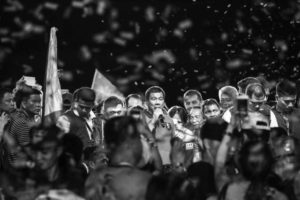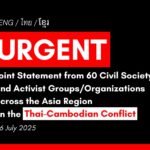06/09/2017
Under: Philippines, Power and Democracy, Publications
What do his pronouncements—for which he’s famous or infamous for and through which most of his policies are crafted and known—tell us in terms of the future direction of his government? Is there anything new, radically, in vision and policies—economic, political, social? What kind of leadership, government, society do we glean from the first year of his presidency? Are we in for a change, as promised during his campaign? Or, as most of the articles you will find in this issue ask, do the policies just show continuity from the past government/s? Is that bad or good? Bad, maybe, in the sense that we have been promised that change is coming.
In the article on Dutertenomics, Joseph Purugganan points out why we were captivated by the promise of change—because millions of Filipinos were “dissatisfied with elite politics and governance, and with the majority (the so-called 99 percent) not benefitting from economic growth.” That “the backlash via popular support for Duterte is being directed more towards the elite bureaucracy and an oligarchy that are both impervious to the needs of the poor.” But President Duterte immediately professed he would be hands-off as far as economic policies are concerned because this was not his forte. Can we therefore expect the same economic recipe as in the past recipe defined by neoliberal orientation?
Some good news though came through the appointment of progressives in the cabinet; and one post which is very important is that of the Department of Agrarian Reform (DAR) secretary’s given to former peasant leader Rafael Mariano. Mary Ann Manahan writes that this “signaled a pro-small farmer and pro-poor agenda of upholding farmers’ rights and re-prioritizing agrarian reform and smallholder agriculture.” However, she characterized Duterte’s countryside agenda as “schizophrenic…: populist promises in favor of the marginalized and poor in the countryside, on one hand, and on the other, a strong bias for agribusiness and big players in the sector…”
Manahan again points out this same style of governance in the environment sector, which she calls “laban-bawi”—one positive step is rendered meaningless by a counter move. But would this be sustainable in a situation where we face an environmental crisis? More of continuity would be seen in this government’s Build, Build, Build program, argues, Manahan in her piece on infrastructure.
In his piece on Duterte’s foreign policy, Galileo de Guzman Castillo invites us to ‘embark’ on a journey of unpacking the president’s “pronouncements and actions over the last 12 months” to find out what Duterte’s “touted in(depend)ent foreign policy” is all about. Can we finally find coherence and consistency here? Is there an opportunity to craft a genuine independent policy, according to our Constitution and laws? What should constitute an independent foreign policy?
Or can we find the radical change in Dutertism’s social reform agenda, which Raphael Baladad unpacks by comparing the lofty vision of the 2017-2022 Philippine Development Plan and the 2017 People’s Budget.
Where lies the coherence, it would become clear, is in the truly distinctive policy of this administration, the war on drugs which has been synonymous to war on the poor. As Clarissa V. Militante argues in her article, “Duterte’s campaign promise to kill drug addicts “hit the ground running immediately after he was sworn into office. On the first year of execution, this violent, uncompromising approach has already resulted in the deaths of 7,000 to 10,000 people.” The numbers may vary but “what is conclusive is that thousands have died as a result of this bloody policy, which the President vowed to continue until the end of his term.




![[IN PHOTOS] In Defense of Human Rights and Dignity Movement (iDEFEND) Mobilization on the fourth State of the Nation Address (SONA) of Ferdinand Marcos, Jr.](https://focusweb.org/wp-content/uploads/2025/07/1-150x150.jpg)

